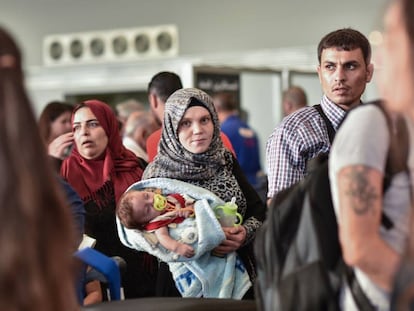Syria begins to rebuild
Survivors of Civil War are starting to return as government begins to restore infrastructure in large cities
The sight of the Al-Sukkari district in Aleppo is enough to reduce anyone to tears. In the most devastated area of one of the world’s oldest cities, more than six years of conflict have turned buildings that were once filled with life into skeletal structures of wire hung with remains of cement.
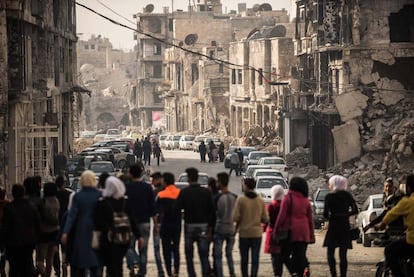
It’s been a year since government forces entered this vibrant urban sprawl and expelled around 2,000 rebels and jihadists who had dug beneath the streets to bomb their opponents. Now there are signs of life emerging from the mounds of rubble: for example, a colorful line of washing on a balcony, indicating that at least one family of refugees has come home.
“We have spent five years living in a school. But this month they told us we had to leave,” says Nahla Jataba, 38, a mother of seven children whose family has returned along with one other to a building in the district that housed 15 families in 2010. “We haven’t heard anything from our neighbors. Some went to Turkey and others to Damascus.”
With almost five million inhabitants, Aleppo was one of Syria’s most densely populated cities until the war triggered an exodus of one million people. Recently around 332,000 have returned to what remains of their homes.
Nahla has asked her brother for a loan of €1,600 – two year’s salary in Syria – to pay for her apartment to be returned to its former state. New off-white bricks contrast with the pockmarked walls of the neighboring dwellings, whose exposed living rooms and bathrooms make them look like dolls’ houses. Her children’s old school can be seen from the balcony, though it is now little more than dust, like 40% of schools across Syria.
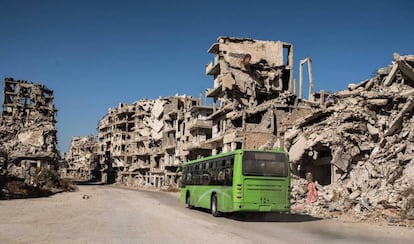
After so many years of war, government troops have won back around 70% of the country – an area home to some 78% of Syrians. They control all the big cities such as Damascus, Homs and Aleppo. Only Raqqa eludes them. The human cost of the war has been between 320,000 and 470,000 lives – a third of these people being civilians. The economic cost is more than €200 billion, with 27% of Syrian homes destroyed, according to World Bank estimates for the period up to the end of 2016. Accompanied by a government official, EL PAÍS has traveled to Damascus, Aleppo and Homs to witness the first attempts to return to normality.
Reconstruction is evident in the roads connecting the cities. Public spaces and cultural heritage sites are high on the agenda. But the 10% of the six million internally displaced people in Syria who have decided to return to their homes are having to foot the bill for the reconstruction of their apartments. Another five million refugees are living in neighboring countries and in Europe. Today, there are 18 million people in Syria, compared to 23 million at the start of the war.
A minefield
“The priority was to clear the neighborhoods of mines and explosives, then clear the streets of rubble. Now we are starting to recover basic services,” says Lama Keyali, from the Aleppo authorities’ press department.
In practical terms we are talking about six years of relentless work to clear 14.9 million tons of rubble left by the war in what was Syria’s economic hub. Never mind that the state coffers have been emptied by the direct cost of the conflict as well as the indirect bill – Syria’s two main sources of income, the production of crude oil and agriculture have fallen by 93% and 40% respectively.
In Aleppo’s city hall they are drawing up a reconstruction plan that still has no price tag. The most war-torn region after Raqqa, Aleppo’s destruction varies from street to street.
Solidarity
Several blocks away from Al Sukkari, Ahmad Halar, 58, enters a building that looks on the verge of collapse. Armed with a flashlight, he reaches the third floor by stairs that appear to be suspended in mid-air. He came to this building after abandoning his home in the Kurdish quarter of Sheij Masoud on June 15, 2014. “The Kurdish militias said that if we wanted to stay, one of my sons should join their ranks,” he says. “I have seven children – well, six, because one died fighting in Al Bab.”
Another three of his sons fought with the Syrian army, he tells us from the living room of his makeshift home. The youngest lies wrapped in blankets on a mattress in front of the TV, recovering from a leg wound. The family lives on €65 a month, a sum that is eked out of his daughter-in-law’s widow’s pension and the money Halar makes from filling barrels of oil in a factory. They can’t afford the €50 it would cost to rent an unfurnished apartment so they have decided to inhabit this ruined building instead. Luckily, they have been shown solidarity from the building’s owner, who doesn’t ask for rent from a stranger who turned up one day with a door to seal up his new home.
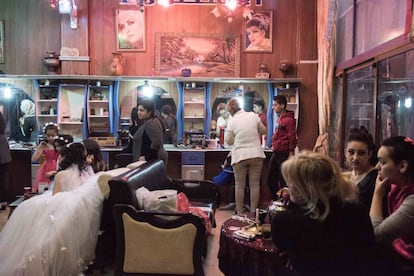
Most of the construction workers and cement lorries can be seen in the public spaces. Approximately 70% of Aleppo’s medieval souk was destroyed in the conflict. But this week a number of shopkeepers have reopened their premises and the market is once again alive with trade. Among the traders is Abd al-Rahman Shisman, 41, a third-generation producer of the famous Aleppo soap. “With the Aleppo factories destroyed, we now produce in Afrin [a Kurdish town in the north],” he explains. In the absence of warplanes or shells flying overhead, the locals have come in droves to visit the old quarter, picking their way around the treacherous potholes. In the distance, cranes can be seen swinging over Aleppo’s Great Mosque while, closer to hand, improvised stalls are being set up in small alleys.
The highway between Damascus and Aleppo smells of recently laid tarmac. There is no evidence of the destruction of 10 months ago. Commuter towns such as Al-Safirah are once again jammed with cars, trucks laden with goods, Russian tanks and vans filled with families squeezed in alongside their worldly possessions.
In Homs, evidence of human suffering is everywhere. The Khalidiya neighborhood is the worst affected, with one building after another bombed out of existence for as far as the eye can see. A handful of friendly soldiers greet bus and taxi drivers who sporadically enter this apocalyptic scene. Various bus routes have been reestablished for the 25 families that have returned to live here.
Coming home
Three women escorted by an adolescent appear out of nowhere. It’s the first time in six years that the Badous family has ventured out to see what remains of their home. Prepared for the worst by years of war, the moment of truth produces neither cries or tears. The women simply put their hands to their mouths or hold their heads. “Look where the curtains have ended up,” says one while picking an old lighter from the ground. “Ooff. There’s nothing left,” says another. With bowed heads, they retreat to their rented apartment, which they now realize will be home for some time to come.
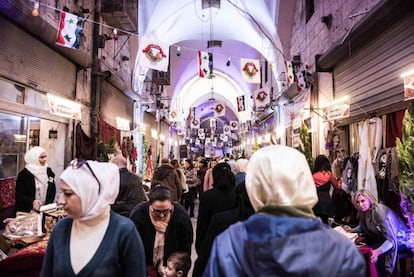
Walls that formerly separated buildings have been torn down to allow soldiers to come and go while snipers clearly used the ruins for cover. A painting of a country house has survived on a wall of what appears to be a living room. On the floor, pieces of clothing and belongings are scattered, evidence of a life. There’s a jasmine tree two meters high thriving among trash in the patio, oblivious to the catastrophic events going on around it.
Weddings and deaths
At midday, the sound of Kalashnikovs comes from the Ferdus cemetery in the center of Homs. The cemetery was meant to be a park but the war changed its role. It is home to hundreds of graves, many containing the corpses of young soldiers, such as Shadi, who was buried by here by his wife and family.
Six years of war in figures
Hundreds of thousands of people, a third of them civilians, have died in the six-year Syrian conflict. Around 320,000, according to the Syrian Observatory for Human Rights, and 470,000 according to the World Bank.
Half of the 23 million Syrians that lived in the country in 2011 have had to flee their homes. Six million remained within Syria while five million sought refuge in neighboring countries and Europe. The conflict has emptied the countryside of inhabitants. The urban population has gone from 56% of the total in 2011 to 72% in 2016.
Some 600,000 internally displaced persons have returned to their homes in 2017, half of them to the province of Aleppo. The World Bank estimates the war has cost the country €200,000 million.
The two main sources of income have taken a significant blow: the production of crude oil and gas has dropped by 93% and agriculture by 40%.
Around 27% of urban homes have been totally or partially destroyed while 50% of medical centers and 43% of schools have been reduced to rubble.
Shadi died on the Hama front, a reminder that while three-quarters of the country are trying to rebuild their lives, the other quarter are still embroiled in the conflict. The graves are dated from 2012 to 2017. Some of the headstones have fallen due to the many terrorist attacks that have rocked the city.
The fighters – rebels, jihadists and government troops – account for 60% of the dead. While the government in Damascus celebrates imminent victory, regions such as Idlib, Deir Ezzor, the fringes of Damascus and Hama are still at war.
But these pockets of conflict don’t deter the rest of the country from making every effort to start afresh. “Of the 30 districts in Homs, 15 have been affected or destroyed by the war,” says Reem Baakbaki, one of the architects at the town hall involved in their rebuilding. As in Aleppo, the authorities have still not come up with a figure to cover costs. One street lamp can be seen between cement piles and tangles of metal. A year ago, a number of shopkeepers opened their premises here and asked the authorities for electricity and water.
As evening falls, shots can be heard. But far from being the shots of war, they are part of a wedding celebration. Sara, 22 is marrying, Mohamed, 30, a soldier who has been given four days’ leave for the occasion from the Abu Kamal front in the south east, the last ISIS stronghold in Syria. Sara gets ready at the Alestora beauty salon where the activity is nothing short of manic. Brides nervously seek their mislaid false eyelashes, and have their nails done and their hair frozen with hairspray.
As in Aleppo, the reconstruction of the souk in Homs is progressing apace. “We have rebuilt 165 of the 380 stores since 2014,” says Bahaa Khuzan, who manages the reconstruction project financed by the UN.
And then there was light
Meanwhile in Damascus, where 4.5 million lived before the war, they are celebrating the return of electricity. “We’ve had power for nearly a month,” says a euphoric Elias in the Christian neighborhood of Bab Tuma.
Damascus has not suffered in the same way as other Syrian cities. It is practically intact, though its inhabitants are inevitably scarred by the war, particularly the one million refugees from war-torn areas outside the city. On the city fringes, however, 76 rebel mortars have killed 33 people and injured 154 others in the last 10 days. Dozens of civilians have also been killed here by Russian and Syrian warplanes dropping bombs.
So while normal life begins to return to the main cities and refugees slowly make their way back to their old homes, the conflict continues to take its toll. The outskirts of Damascus are a no-go area for journalists. In districts such as Jubar, Meliha, Darayya and Yarmouk Camp, which EL PAÍS has covered in recent years, barely 25% of the population remains and so far no one has ventured in to assess the extent of the damage.
The Lebanese effect
The infernal traffic returns to the streets of the capital where people appear to have adopted a kind of “seize the day” mentality similar to that which pervaded post-war Lebanon. “People want to get back to living, so no one is bothered about being careful with money,” says Muna, a French-language student in Damascus. Bars, cafés and restaurants are mushrooming, many without licenses. This Lebanese effect has even extended to an obsession with appearance. Now the Syrian capital has become a mecca for cosmetic surgery, with patients splashing out on a nose job or breast implants.
Getting married is another serious trend in Syria among young people facing an unemployment rate of 78%. “The wedding cost €350, without counting the house, of course,” says Mohamed, 30, who is marrying Sara, 22.
Brides hire wedding dresses at a cost of between €15 and €30 and the wedding banquet has been reduced to drinks and a snack. The population may be grieving but these couples have decided to start a new life. And if that means debts, then they’ll deal with them when and if the time comes.
English version by Heather Galloway.
Tu suscripción se está usando en otro dispositivo
¿Quieres añadir otro usuario a tu suscripción?
Si continúas leyendo en este dispositivo, no se podrá leer en el otro.
FlechaTu suscripción se está usando en otro dispositivo y solo puedes acceder a EL PAÍS desde un dispositivo a la vez.
Si quieres compartir tu cuenta, cambia tu suscripción a la modalidad Premium, así podrás añadir otro usuario. Cada uno accederá con su propia cuenta de email, lo que os permitirá personalizar vuestra experiencia en EL PAÍS.
¿Tienes una suscripción de empresa? Accede aquí para contratar más cuentas.
En el caso de no saber quién está usando tu cuenta, te recomendamos cambiar tu contraseña aquí.
Si decides continuar compartiendo tu cuenta, este mensaje se mostrará en tu dispositivo y en el de la otra persona que está usando tu cuenta de forma indefinida, afectando a tu experiencia de lectura. Puedes consultar aquí los términos y condiciones de la suscripción digital.
More information
Archived In
Últimas noticias
The complicated life of Francesca Albanese: A rising figure in Italy but barred from every bank by Trump’s sanctions
Half of Scotland is in the hands of 420 property owners
Pinochet’s victims grapple with José Antonio Kast’s rise in Chile
Reinhard Genzel, Nobel laureate in physics: ‘One-minute videos will never give you the truth’
Most viewed
- Pablo Escobar’s hippos: A serious environmental problem, 40 years on
- Why we lost the habit of sleeping in two segments and how that changed our sense of time
- Charles Dubouloz, mountaineering star, retires at 36 with a farewell tour inspired by Walter Bonatti
- Reinhard Genzel, Nobel laureate in physics: ‘One-minute videos will never give you the truth’
- The Florida Keys tourist paradise is besieged by immigration agents: ‘We’ve never seen anything like this’


